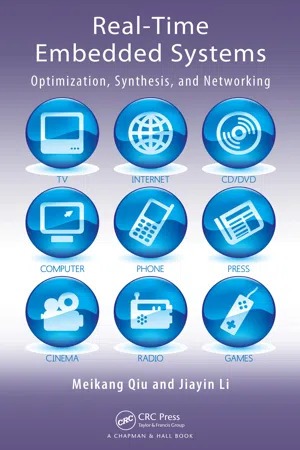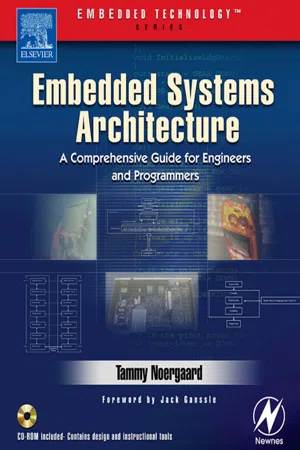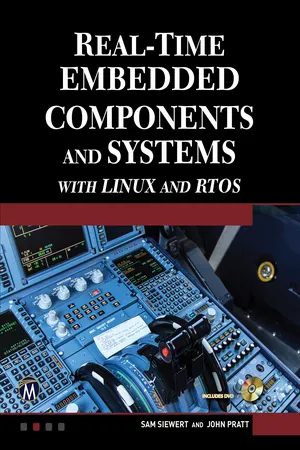Computer Science
Characteristics of Embedded Systems
Embedded systems are specialized computing systems designed to perform specific functions within larger systems. They are characterized by real-time operation, low power consumption, and often have limited resources such as memory and processing power. Embedded systems are commonly found in everyday devices such as smartphones, household appliances, and automotive systems.
Written by Perlego with AI-assistance
Related key terms
1 of 5
9 Key excerpts on "Characteristics of Embedded Systems"
- eBook - PDF
Real-Time Embedded Systems
Optimization, Synthesis, and Networking
- Meikang Qiu, Jiayin Li(Authors)
- 2011(Publication Date)
- CRC Press(Publisher)
Even though the em-bedded systems may not have the same computational power as the general purpose computers, they contribute a huge part in the modern world. In 2004, a family may have two or three computers, while more than 300 embedded systems exist in a normal family home. With the advance of the technology, embedded systems with multiple cores or VLIW-like architectures, such as multicore network processors, TI’s TMS320C6x, Philips’ TriMedia, IBM cell processor, and IA64, etc., become necessary to achieve the required high performance for the applications with 1 2 Real-Time Embedded Systems: Optimization, Synthesis, and Networking growing complexity. However, the computer-aided design capability of embed-ded systems has become a severe bottleneck for productivity. The design of parallel and heterogeneous embedded systems poses a host of technical chal-lenges different from those faced by general-purpose computers because they have much larger design space and are more constrained in terms of timing, power, area, memory and other resources. Common Characters. Embedded systems have several common char-acteristics that distinguish such systems from other computing systems [210, 212]: • Single-functioned: An embedded system usually executes a specific pro-gram repeatedly. For example, a pager is always a pager. • Tightly constrained: All computing systems have constraints on design metrics, but those on embedded systems can be especially tight. A design metric is a measure of an implementation’s features, such as cost, size, performance, and power. Embedded systems often must cost just a few dollars, must be sized to fit on a single chip, must perform fast enough to process data in real-time, and must consume minimum power to extend battery life or prevent the necessity of a cooling fan. • Reactive and real-time: Many embedded systems must continually react to changes in the system’s environment and must compute certain re-sults in real-time without delay. - No longer available |Learn more
- (Author)
- 2014(Publication Date)
- Research World(Publisher)
____________________ WORLD TECHNOLOGIES ____________________ Chapter 10 Embedded System Picture of the internals of an ADSL modem/router. A modern example of an embedded system. Labelled parts include a microprocessor (4), RAM (6), and flash memory (7). ____________________ WORLD TECHNOLOGIES ____________________ An embedded system is a computer system designed to perform one or a few dedicated functions often with real-time computing constraints. It is embedded as part of a complete device often including hardware and mechanical parts. By contrast, a general-purpose computer, such as a personal computer (PC), is designed to be flexible and to meet a wide range of end-user needs. Embedded systems control many devices in common use today. Embedded systems are controlled by one or more main processing cores that are typically either microcontrollers or digital signal processors (DSP). The key characteristic, however, is being dedicated to handle a particular task, which may require very powerful processors. For example, air traffic control systems may usefully be viewed as embedded, even though they involve mainframe computers and dedicated regional and national networks between airports and radar sites (each radar probably includes one or more embedded systems of its own). Since the embedded system is dedicated to specific tasks, design engineers can optimize it to reduce the size and cost of the product and increase the reliability and performance. Some embedded systems are mass-produced, benefiting from economies of scale. Physically, embedded systems range from portable devices such as digital watches and MP3 players, to large stationary installations like traffic lights, factory controllers, or the systems controlling nuclear power plants. Complexity varies from low, with a single microcontroller chip, to very high with multiple units, peripherals and networks mounted inside a large chassis or enclosure. - No longer available |Learn more
- (Author)
- 2014(Publication Date)
- College Publishing House(Publisher)
________________________ WORLD TECHNOLOGIES ________________________ Chapter 1 Introduction to Embedded System Picture of the internals of an ADSL modem/router. A modern example of an embedded system. Labelled parts include a microprocessor (4), RAM (6), and flash memory (7). An embedded system is a computer system designed to perform one or a few dedicated functions often with real-time computing constraints. It is embedded as part of a complete device often including hardware and mechanical parts. By contrast, a general-purpose computer, such as a personal computer (PC), is designed to be flexible and to meet a wide range of end-user needs. Embedded systems control many devices in common use today. Embedded systems are controlled by one or more main processing cores that are typically either microcontrollers or digital signal processors (DSP). The key characteristic, how- ________________________ WORLD TECHNOLOGIES ________________________ ever, is being dedicated to handle a particular task, which may require very powerful processors. For example, air traffic control systems may usefully be viewed as embedded, even though they involve mainframe computers and dedicated regional and national networks between airports and radar sites (each radar probably includes one or more embedded systems of its own). Since the embedded system is dedicated to specific tasks, design engineers can optimize it to reduce the size and cost of the product and increase the reliability and performance. Some embedded systems are mass-produced, benefiting from economies of scale. Physically, embedded systems range from portable devices such as digital watches and MP3 players, to large stationary installations like traffic lights, factory controllers, or the systems controlling nuclear power plants. Complexity varies from low, with a single microcontroller chip, to very high with multiple units, peripherals and networks mounted inside a large chassis or enclosure. - Ahmad Ibrahim(Author)
- 2003(Publication Date)
- Newnes(Publisher)
It appears that the amount of software used per consumer product is doubling roughly every two years. The trend appears to be con-tinuing and the number of familiar and new consumer products using all the capabilities of IC technology is increasing as prices become suitable for consumers. One has to be careful, however, when talking about the amount of software. The number of lines of code and their rate of execution would not be enough to evaluate the performance of a system independent of what a code instruction can do. Manufacturers appear to depend on software to improve the user inter-face of products. They also depend more and more on software in introducing the product diversity needed in the market while maintaining the minimum hardware variety to ensure economical mass production. Some of the features of embedded computing systems include: Embedded Systems: An Overview 3 ■ Tightly-Constrained Specifications Embedded computing systems typically have particularly tight design specifications. The physical dimensions of the system usually need to be small, requiring the system to fit on a single chip. The cost is required to be low as well. In most cases, the system must continually react to changes in its environment and to process the data fast enough as the changes occur (real-time operation). ■ Reliability Bugs in embedded computing systems cannot be tolerated, as opposed to personal computing where software bugs are mere inconveniences. Rigorous systematic testing and commissioning are required. Implementing an embed-ded system with hardware or software problems could lead to serious consequences. For example, one significant software error in a life-support system or a transportation system could be fatal. The need for assured reliability becomes increasingly demanding consid-ering the fact that numerous products with embedded systems have a relatively short life cycle. They tend to become obsolete due to technological changes.- eBook - PDF
Embedded Systems Architecture
A Comprehensive Guide for Engineers and Programmers
- Tammy Noergaard(Author)
- 2005(Publication Date)
- Newnes(Publisher)
However, you will find that the definition of “embedded system” is fluid and difficult to pin down, as it constantly evolves with advances in technology and dramatic decreases in the cost of implementing vari-ous hardware and software components. In recent years, the field has outgrown many of its traditional descriptions. Because the reader will likely encounter some of these descriptions and definitions, it is important to understand the reasoning behind them and why they may or may not be accurate today, and to be able to discuss them knowledgeably. Following are a few of the more common descriptions of an embedded system: Embedded systems are more limited in hardware and/or software functionality than a personal computer (PC). This holds true for a significant subset of the embed-ded systems family of computer systems. In terms of hardware limitations, this can mean limitations in processing performance, power consumption, memory, hardware functionality, and so forth. In software, this typically means limitations relative to a PC—fewer applications, scaled-down applications, no operating system (OS) or a limited OS, or less abstraction-level code. However, this definition is only partially true today as boards and software typically found in PCs of past and present have been repackaged into more complex embedded system designs. An embedded system is designed to perform a dedicated function. Most embedded devices are primarily designed for one specific function. However, we now see devices such as personal data assistant (PDA)/cell phone hybrids, which are embed-ded systems designed to be able to do a variety of primary functions. Also, the latest digital TVs include interactive applications that perform a wide variety of general In This Chapter Define embedded system Introduce the design process Define an embedded systems architecture Discuss the impact of architecture Summarize the remaining sections of the book - eBook - PDF
Computers as Components
Principles of Embedded Computing System Design
- Marilyn Wolf(Author)
- 2008(Publication Date)
- Morgan Kaufmann(Publisher)
The ASC T control unit has two microprocessors on two printed circuit boards, one of which concentrates on logic-relevant components and the other on performance-specific components. 1.1.2 Characteristics of Embedded Computing Applications Embedded computing is in many ways much more demanding than the sort of programs that you may have written for PCs or workstations. Functionality is 1.1 Complex Systems and Microprocessors 5 important in both general-purpose computing and embedded computing, but embedded applications must meet many other constraints as well. On the one hand, embedded computing systems have to provide sophisticated functionality: ■ Complex algorithms: The operations performed by the microprocessor may be very sophisticated. For example, the microprocessor that controls an automobile engine must perform complicated filtering functions to opti-mize the performance of the car while minimizing pollution and fuel utilization. ■ User interface: Microprocessors are frequently used to control complex user interfaces that may include multiple menus and many options. The moving maps in Global Positioning System (GPS) navigation are good examples of sophisticated user interfaces. To make things more difficult, embedded computing operations must often be performed to meet deadlines: ■ Real time: Many embedded computing systems have to perform in real time— if the data is not ready by a certain deadline, the system breaks. In some cases, failure to meet a deadline is unsafe and can even endanger lives. In other cases, missing a deadline does not create safety problems but does create unhappy customers—missed deadlines in printers,for example,can result in scrambled pages. ■ Multirate: Not only must operations be completed by deadlines, but many embedded computing systems have several real-time activities going on at the same time. They may simultaneously control some operations that run at slow rates and others that run at high rates. - No longer available |Learn more
- Sam Siewert, John Pratt(Authors)
- 2016(Publication Date)
- Mercury Learning and Information(Publisher)
4 • REAL-TIME EMBEDDED COMPONENTS AND SYSTEMS WITH LINUX AND RTOS A common way to define real time as a noun is the time during which a process takes place or occurs. Used as an adjective, real-time relates to computer applications or processes that can respond with low bounded la- tency to user requests. One of the best and most accurate ways to define real time for computing systems is to clarify what is meant by correct real- time behavior. A correct real-time system must produce a functionally (al- gorithmically and mathematically) correct output response prior to a well- defined deadline relative to the request for a service. The concept of embedded systems has a similar and related history to real-time systems and is mostly a narrowing of scope to preclude general- purpose desktop computer platforms that might be included in a real-time system. For example, the NASA Johnson Space Center mission control center includes a large number of commercial desktop workstations for processing of near real-time telemetry data. Often desktop real-time sys- tems provide only soft real-time services or near real-time services rather than hard real-time services. Embedded systems typically provide hard real-time services or a mixture of hard and soft real-time services. Again, a commonsense definition of embedding is helpful for under- standing what is meant by a real-time embedded system. Embedding means to enclose or implant as essential or characteristic. From the viewpoint of computing systems, an embedded system is a special-purpose computer completely contained within the device it controls and not directly observ- able by the user of the system. An embedded system performs specific predefined services rather than user-specified functions and services as a general-purpose computer does. The real-time embedded systems industry is full of specialized termi- nology that has developed as a subset of general computing systems termi- nology. - eBook - PDF
- Vojin G. Oklobdzija(Author)
- 2019(Publication Date)
- CRC Press(Publisher)
5.2 Requirements on Embedded SoCs A digital system typically uses embedded processors to meet a combination of performance, complexity, and possibly design time goals. If the system’s behavior is very regular and easy to specify as hardware, it may not be necessary to use embedded software. An embedded processor becomes more attractive when the behavior is too complex to be easily captured in hardwired logic. Using embedded processors may reduce design time by allowing the design to be separated into distinct software and hardware units. In many cases, the CPU will be predesigned; even if the CPU and associated hardware is being designed for the project, many aspects of the hardware design can be performed separately from the software design. (Experience with embedded system designs does show, however, that the hardware and software designs are intertwined and that embedded software is prone to some of the same scheduling problems as mainframe software projects.) But even if embedded processors seem attractive by reducing much of the design to ‘‘just program-ming,’’ it must be remembered that embedded software design is much more challenging than typical applications programming for workstations or PCs. Embedded software must be designed to meet not just functional requirements—the software’s input and output behavior—but also stringent nonfunc-tional requirements. Those nonfunctional requirements include: . Performance —Although all programmers are interested in speed of execution, performance is measured much more precisely in the typical embedded system. Many embedded systems must meet real-time deadlines. The deadline is measured between two points in the software: if the program completely executes from the starting point to the end point by the deadline, the system malfunctions. . Energy = power —Traditional programmers don’t worry about power or energy consumption. However, energy and power are important to most embedded systems. - eBook - PDF
Computer Aided Control System Design: Methods, Tools And Related Topics
Methods, Tools and Related Topics
- Mietek A Brdys, K Malinowski(Authors)
- 1994(Publication Date)
- World Scientific(Publisher)
Part II Related Topics Part II Related Topics This page is intentionally left blank The Future of Real-Time and Embedded Computing Systems Borko Furht, Wolfgang A. Halang Florida Atlantic University Dept. of Computer Science and Engineering Boca Raton, FL 33431-0991, U.S.A. FernUniversitat Dept. of Electrical Engineering D-58084 Hagen, Germany Abstract In this article we present the state-of-the-art of real-time and embedded computing systems by emphasising those developments likely to have impact on future real-time systems. We discuss real-time and embedded systems from both software and hardware points of view, including a retrospective of major developments of the past. The critical issues are presented from two different viewpoints: from a real-time computer vendor and an academic researcher. Fi-nally, we take the liberty of predicting how a real-time computer of the next decade will look alike, both from computer manufacturer's and academic per-spectives. 1 Introduction 1.1 Overview of Real-Time Applications Response time and data throughput requirements of a real-time system depend on the specific real-time application. For example, in an energy management system, the main function is to monitor and control environmental factors such as temperature and air flow. The computational requirements for this application are modest, be-cause of the relatively low sampling rates and slow overall response of the mechanical devices affecting changes within the system. In an electrical power plant, however, data acquisition and calculation become more critical. Plant equipment and system functions must be closely monitored and controlled on a continuous basis to ensure safe operation and prevent costly unscheduled outages and shutdowns. A slight devia-tion from optimal performance even for a short period of time can significantly impact the cost of electrical energy produced by the plant, illustrates various response time requirements for typical real-time applications.
Index pages curate the most relevant extracts from our library of academic textbooks. They’ve been created using an in-house natural language model (NLM), each adding context and meaning to key research topics.








